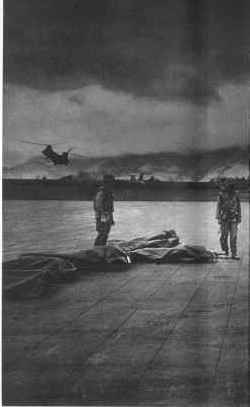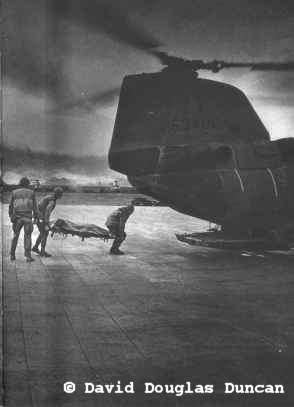'Super Gaggle' of Sea Knights
Sustained Khe Sanh's Battered Outposts
(Click on photo for a larger
image)
Definition of 'Super Gaggle':
Helicopter pilots refer to a formation flight of helicopters as a gaggle,
as in a 'gaggle of geese.' Therefore, when as many helicopters were
in the sky supporting Khe Sanh's besieged outposts, it was called a Super
Gaggle.
During the period from 24
February to 9 April 1968, the time frame of the "Super Gaggle", it was
my privilege to witness some of the most outstanding demonstrations of
sustained exceptional aeronautical skill and so many displays of unparalleled
courage that it would require a full length book to describe them individually
and adequately. Never in my career as a Marine aviator have I seen
such awesome responsibility placed on the shoulders of air crews, nor seen
such perfection in the briefing and execution of every minute detail of
flying combat missions.
J. A. "Al" Chancey
LtCol. USMC (Ret)
It was during this period that Khe Sanh was under siege
by a North Vietnamese Army (NVA) force which reached a peak of more than
30,000, or six times the number of US Marines which were garrisoned there.
Logistical support by ground over the Old Colonial Highway, or Route 9,
had become impossible due to the concentration of NVA forces and the monsoons
washing bridges away. Logistical support by air also became so hazardous
that only the plight of the Marines and the President's order to 'Hold
Khe Sanh' could justify the terrible losses of aircraft encountered in
resupply attempts.
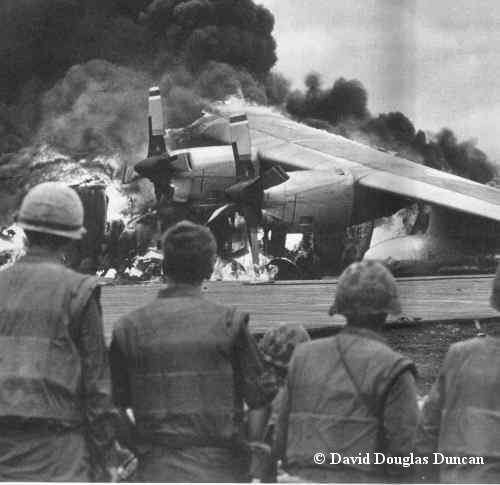 Several
C-130s and C-123's were were destroyed on Khe Sanh's airstrip while attempting
to bring in the supplies required to 'Hold Khe Sanh.' (Click
here for additional photos and narrative of Khe Sanh) The enemy
siege became so tight that C-130s were finally prevented from landing and
were forced to resort to paradropping the supplies, some of which fell
to earth outside the perimeter of Khe Sanh and became sustenance for the
enemy. This still did not solve the problem of resupplying the ever
more besieged outposts around Khe Sanh, and helicopters sill had to brave
the heavy mortar, artillery, rocket and automatic weapons fire to carry
the critical supplies from Khe Sanh to the surrounding outposts.
The losses of helicopters in the attempt became so numerous it was obvious
a less costly method had to be developed if the outposts were to be held.
Several
C-130s and C-123's were were destroyed on Khe Sanh's airstrip while attempting
to bring in the supplies required to 'Hold Khe Sanh.' (Click
here for additional photos and narrative of Khe Sanh) The enemy
siege became so tight that C-130s were finally prevented from landing and
were forced to resort to paradropping the supplies, some of which fell
to earth outside the perimeter of Khe Sanh and became sustenance for the
enemy. This still did not solve the problem of resupplying the ever
more besieged outposts around Khe Sanh, and helicopters sill had to brave
the heavy mortar, artillery, rocket and automatic weapons fire to carry
the critical supplies from Khe Sanh to the surrounding outposts.
The losses of helicopters in the attempt became so numerous it was obvious
a less costly method had to be developed if the outposts were to be held.
An imaginative plan, the "Super Gaggle," was developed
to resupply the beleaguered outposts by helicopter from Dong Ha.
The plan had one very serious drawback, the heavy monsoon weather prevented
VFR (visual flight rules) through the high hazardous terrain between Dong
Ha and Khe Sanh. Another detrimental factor was the Khe Sanh TACAN
(tactical air navigation) and GCA (ground
controlled radar approach) facilities were inoperative most of the time
due to constant enemy bombardment.
The plan was a bold one that would require complex
planning involving large numbers of aircraft under instrument conditions
in a small area, one in which only perfection would be acceptable in its
execution. Fully aware of the aeronautical skill required and the
hazards that would be involved, the courageous pilots of HMM-364 readily
accepted this tremendous challenge.
The concept of operations involved picking up maximum
weight external loads at Dong Ha, climbing out under IFR (instrument flight
rules) on an obstacle clear radial of the Dong Ha TACAN
toward Khe Sanh with eight to ten aircraft, and rendezvousing over
Khe Sanh for a wave resupply of a designated outpost. If the flight
was not able to reach VFR (visual flight rules) on top, or find a break
in in the overcast to allow a spiral down through the cloud cover near
Khe Sanh, it would do a 180o turn climb to a pre briefed altitude
and return to either Quang Tri or Dong Ha for an instrument approach.
The instrument approaches utilized were either the TACAN which had helicopter
minimums
of a 600'ceiling and 1/2
mile visibility or the GCA which had helicopter
minimums of a 200' ceiling
and 1/4 mile visibility.
The worst of weather conditions prevailed throughout
most of the Khe Sanh emergency resupply operations. Many times the
pilots launched on their missions IFR when the weather at Dong Ha was well
below TACAN minimums and on several occasions even below GCA minimums.
It was hazardous, even without the threat of enemy fire, but the Purple
Fox air crews were determined not to leave their fellow Marines without
the means of combating the enemy forces. They continued to launch!
When the flight arrived over Khe Sanh the awesome task
was only beginning. The hilltop zones of 881S, 861, 861A,
558, 950 and 1015 (see maps) were generally
small and hazardous, they were well registered with enemy mortar, and the
area immediately outside the small perimeter was infested with automatic
weapons and snipers which were deadly to the slow moving vulnerable helicopters,
and no amount of fixed wing and artillery prep was able to silence all
of them. As the helicopters made their approach to 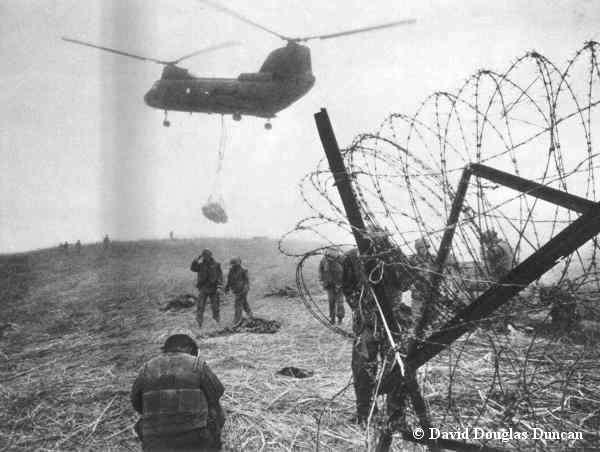 the
zones and hovered over it, as depicted here at Hill 861A to drop their
loads, automatic weapons opened up from all quadrants. Ground troops
around the zone dived into their trenches, for invariably the arrival of
the helicopters brought with them a barrage of mortars. In total
disregard for their own safety the pilots continued to make their approaches
to the zones erupting with mortar rounds and criss-crossed with automatic
weapons fire. When their designated landing zone blew up in front
of them, which was frequently, the courageous, determined pilots maneuvered
their aircraft left or right slightly and delivered their precious loads
anyway. The tighter the perimeters grew, and the more intense the
enemy fire, the more critical the ammunition, food, water, medical supplies
and replacement troops became. The Marines manning the outposts would
not be abandoned.
the
zones and hovered over it, as depicted here at Hill 861A to drop their
loads, automatic weapons opened up from all quadrants. Ground troops
around the zone dived into their trenches, for invariably the arrival of
the helicopters brought with them a barrage of mortars. In total
disregard for their own safety the pilots continued to make their approaches
to the zones erupting with mortar rounds and criss-crossed with automatic
weapons fire. When their designated landing zone blew up in front
of them, which was frequently, the courageous, determined pilots maneuvered
their aircraft left or right slightly and delivered their precious loads
anyway. The tighter the perimeters grew, and the more intense the
enemy fire, the more critical the ammunition, food, water, medical supplies
and replacement troops became. The Marines manning the outposts would
not be abandoned.
Frequently the flight commenced its approach when the
ground could only be seen through very small holes in the clouds and the
ceiling was very low, necessitating long low approaches exposed to close
range automatic weapons fire and sniper fire. Even when the hilltop
landing zones were covered with clouds the determined pilots would not
be deterred. On several occasions approaches were made and the mission
completed when the LZ was IFR. This was accomplished by flying low
up the valleys under the cloud base, entering the clouds at the base of
the hill, and air taxiing up the side of the hill while looking straight
down to maintain visual reference with the ground. This was hazardous
enough with only one plane involved, but with eight to ten aircraft making
the approach to the same zone under close range enemy fire it was sheer
madness, justified only by the urgency of the mission and the exceptional
skill of the pilots involved. These types of air crew actions epitomize
the understanding the Purple Foxes had of their mission in Vietnam which
was, "support the Grunts."
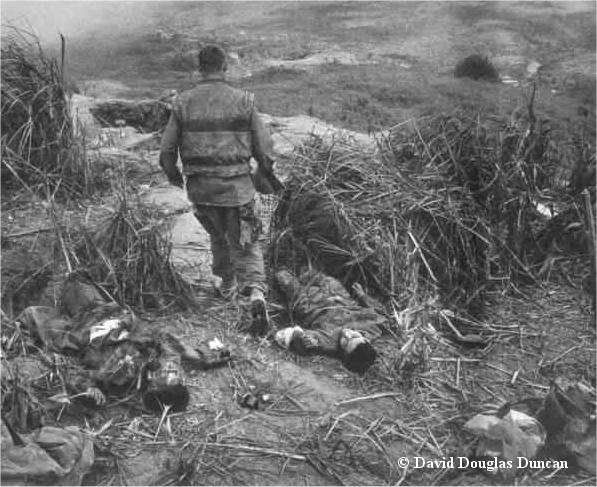 On
many occasions the crews, upon arriving at their designated outposts, would
see lifeless forms lying on the ground as depicted here at Hill 861A.
If a man lay uncovered upon the ground, he was a North Vietnamese soldier,
just fallen, soon to be buried by the Marines. If a man on the ground
or litter had been covered with a poncho, he was a Marine killed in action
and awaiting evacuation to the rear, and the journey to his family.
Not much more could be done, in war, for the dead of either side.
Therefore, when the initial loads from Dong Ha had been delivered for a
particular outpost there were still the dead and other Marines requiring
immediate medical assistance which needed to be evacuated to Khe Sanh and
from Khe Sanh to Dong Ha. Many times these crews would pick up, or
deliver, medevacs at Khe Sanh with mortars and artillery shells falling
all around them. If the rounds got too close for them to remain in
the zone the pilot would lift out, circle once and immediately land again
to complete his mission. If the lead aircraft was significantly damaged
the chase aircraft, without hesitation, would continue where the other
aircraft and crew left off.
On
many occasions the crews, upon arriving at their designated outposts, would
see lifeless forms lying on the ground as depicted here at Hill 861A.
If a man lay uncovered upon the ground, he was a North Vietnamese soldier,
just fallen, soon to be buried by the Marines. If a man on the ground
or litter had been covered with a poncho, he was a Marine killed in action
and awaiting evacuation to the rear, and the journey to his family.
Not much more could be done, in war, for the dead of either side.
Therefore, when the initial loads from Dong Ha had been delivered for a
particular outpost there were still the dead and other Marines requiring
immediate medical assistance which needed to be evacuated to Khe Sanh and
from Khe Sanh to Dong Ha. Many times these crews would pick up, or
deliver, medevacs at Khe Sanh with mortars and artillery shells falling
all around them. If the rounds got too close for them to remain in
the zone the pilot would lift out, circle once and immediately land again
to complete his mission. If the lead aircraft was significantly damaged
the chase aircraft, without hesitation, would continue where the other
aircraft and crew left off.
Evacuating the dead from Khe Sanh to Dong Ha
1stLt. Bruce M. Geiger, USMC, of Golf Battery, 65th
Artillery describes his flight to Khe Sanh and more. "My flight
from Phu Bai was a memorable occasion. We were briefed by the crew
chief to expect heavy ground fire including .50-caliber machine gun, mortar,
and artillery rounds. The crew chief had us lay our gear bags on
the floor beneath us to shield our bodies from ground fire that might penetrate
the underside of the chopper. Needless to say, we were all very nervous
and "puckered" at the thought of .50-caliber rounds ripping through the
thin underbelly of the chopper beneath us! We would circle down through
a heavy cloud cover and have only a few seconds with the tailgate on the
ground to disembark with all our gear. As we began our descent, we
saw tracer rounds streaking past the windows through the clouds.
The crew chief shouted that we would have less than ten seconds on the
deck, and we had better be off the ramp or know how to fly!
Upon landing there were mortars and artillery rounds
exploding all around the landing area. The crew chief lowered the
ramp and we were dumped out like a heap of garbage from the rear of a sanitation
truck. We scattered like rats for the nearest trench line or
bunker and waited in sheer terror for what seemed like an endless barrage
to be over. The chopper disappeared back into the clouds.
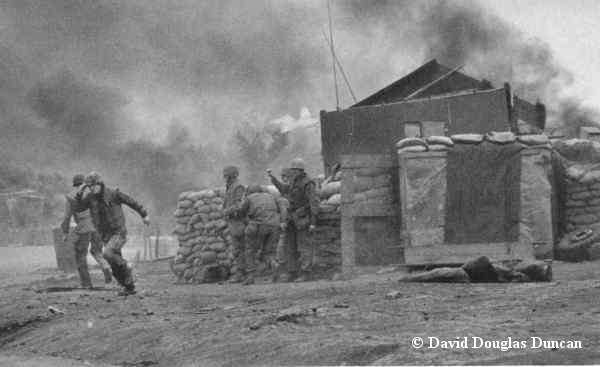 Khe
Sanh was a very bad place then, but the airstrip was the worst place in
the world. It was what Khe Sanh had instead of a V-ring, the exact,
predictable object of the mortars and rockets hidden in the surrounding
hills, the sure target of the big Russian and Chinese guns lodged in the
side of CoRoc Ridge, eleven kilometers away across the Laotian border.
There was nothing random about the shelling there, and no one wanted anything
to do with it. If the wind was right, you could hear the NVA .50-calibers
starting far up the valley whenever an aircraft made its approach to the
strip, and the first incoming artillery would precede the landings by seconds.
If you were waiting there to be taken out, there was nothing you could
do but curl up in the trench and try to make yourself small, and if you
were coming in on the aircraft, there was nothing you could do, nothing
at all."
Khe
Sanh was a very bad place then, but the airstrip was the worst place in
the world. It was what Khe Sanh had instead of a V-ring, the exact,
predictable object of the mortars and rockets hidden in the surrounding
hills, the sure target of the big Russian and Chinese guns lodged in the
side of CoRoc Ridge, eleven kilometers away across the Laotian border.
There was nothing random about the shelling there, and no one wanted anything
to do with it. If the wind was right, you could hear the NVA .50-calibers
starting far up the valley whenever an aircraft made its approach to the
strip, and the first incoming artillery would precede the landings by seconds.
If you were waiting there to be taken out, there was nothing you could
do but curl up in the trench and try to make yourself small, and if you
were coming in on the aircraft, there was nothing you could do, nothing
at all."
The air crews of HMM-364 arose each morning before
daylight, flew two to five of these trips per day into Khe Sanh and its
outposts, and returned after dark. Any one of these days, or any
one of the trips for that matter, may well have merited a significant award
for gallantry under extreme conditions. The fact is though, that
the same crews willingly and courageously flew these same missions day
after day for 45 consecutive days, with only an occasional Andy break,
without thinking about awards, but rather thinking of the Marines who needed
their support. During this period the pilots of HMM-364 flew 422.2
hours of actual instrument time and 246 radar departures and
approaches. Much of this was with maximum weight external loads.
Only those who have done it can appreciate the difficulty encountered in
flying under actual instrument conditions with a heavy external load rocking
the aircraft 15o from side to side and pitching the nose up
and down 10o to 20o. It was a constant fight
to combat vertigo (or spatial disorientation) induced by the gyrations
of the helicopter in response to the swinging load. Recovery from
these conditions, under actual IFR conditions, is rendered even more difficult
by the basic instability of the helicopter itself.
The strain of the furious pace and the constant exposure
to extreme danger was mirrored in the eyes of the weary crews, but not
a complaint was heard. The fact that they continued to contribute
willingly and with determination was a tribute to their stamina, courage
and exceptional aeronautical skill. Through their valiant efforts,
and only through their efforts, were the outposts around Khe Sanh sustained
and provided with the means of holding the area and maintaining constant
surveillance of the enemy until relief could come by road and break the
siege on 9 April 1968.
Information provided by:
J. A. (Al) Chancey, LtCol. USMC
(Ret)
War Without Heroes, Harper and
Row, 1970
David Douglas Duncan
John Sabol, Jr., former Sgt. USMC
Boeing Helicopter News, January
1969
Bruce M. Geiger, former 1stLt.
USMCR
Federation of American Scientists
Back Browser or History
Index or Home
 Several
C-130s and C-123's were were destroyed on Khe Sanh's airstrip while attempting
to bring in the supplies required to 'Hold Khe Sanh.' (Click
here for additional photos and narrative of Khe Sanh) The enemy
siege became so tight that C-130s were finally prevented from landing and
were forced to resort to paradropping the supplies, some of which fell
to earth outside the perimeter of Khe Sanh and became sustenance for the
enemy. This still did not solve the problem of resupplying the ever
more besieged outposts around Khe Sanh, and helicopters sill had to brave
the heavy mortar, artillery, rocket and automatic weapons fire to carry
the critical supplies from Khe Sanh to the surrounding outposts.
The losses of helicopters in the attempt became so numerous it was obvious
a less costly method had to be developed if the outposts were to be held.
Several
C-130s and C-123's were were destroyed on Khe Sanh's airstrip while attempting
to bring in the supplies required to 'Hold Khe Sanh.' (Click
here for additional photos and narrative of Khe Sanh) The enemy
siege became so tight that C-130s were finally prevented from landing and
were forced to resort to paradropping the supplies, some of which fell
to earth outside the perimeter of Khe Sanh and became sustenance for the
enemy. This still did not solve the problem of resupplying the ever
more besieged outposts around Khe Sanh, and helicopters sill had to brave
the heavy mortar, artillery, rocket and automatic weapons fire to carry
the critical supplies from Khe Sanh to the surrounding outposts.
The losses of helicopters in the attempt became so numerous it was obvious
a less costly method had to be developed if the outposts were to be held.


